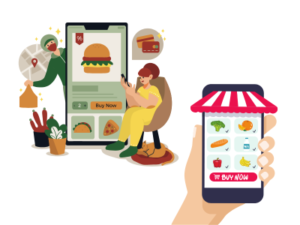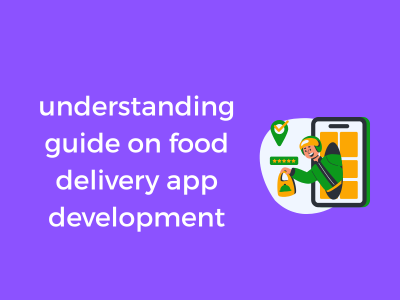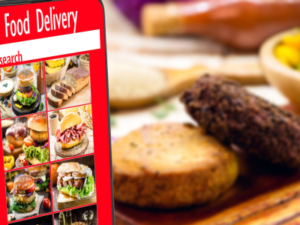Food delivery, as we know it today, didn’t happen overnight—it’s been a fascinating journey! If you’re thinking about developing a food delivery app or are just curious about this booming industry, understanding its evolution can provide insights and inspiration for your project.
Key Ingredients to Build a User-Friendly Food Delivery App
Building a food delivery app that users love involves more than just creating a platform for ordering meals. It’s an experience—a seamless, enjoyable journey that users want to repeat. So, what are the “key ingredients” to crafting a user-friendly app? Let’s explore the essentials to get it right!
1. Know Your Audience
First things first—you need to know who you’re cooking for! Are your users primarily busy professionals looking for quick eats, families craving comfort food, or health-conscious diners? Understanding their preferences will guide every decision you make, from interface design to features offered. Consider conducting surveys, interviews, or user research to get a crystal-clear picture of your audience.
2. Prioritize Simplicity
Users are hungry (literally and figuratively), and no one likes fumbling with a complicated app when they’re just trying to grab a meal. Aim for a simple and intuitive design. A clean layout, clear navigation, and easy-to-read fonts can go a long way. Make sure anyone, tech-savvy or not, can glide through the ordering process with ease.
3. Streamline Registration & Login
No one enjoys filling out lengthy forms. Offer quick registration options, like signing up through Google, Apple, or other social platforms. For returning users, make sure your login process is fast and maybe even integrate biometric login (like fingerprints or facial recognition) for ultimate convenience.
4. Search & Filter Features
Food delivery is all about choices—users should easily find what they’re craving, whether it’s sushi, burgers, or vegan options. Implement a robust search bar with filters for cuisine types, dietary preferences, delivery time, and cost. A personalized recommendation engine is also a great cherry on top!
5. A Detailed Menu with High-Quality Imagery
People eat with their eyes first! Showcase high-quality images of dishes alongside detailed descriptions, pricing, and portion sizes. Bonus points for adding customer reviews and ratings for dishes—it builds trust and reduces “what-if” anxiety for new customers.

6. Smooth Order Tracking
The waiting game can be nerve-wracking. Integrate real-time order tracking so users know where their food is at all times. Clear updates like “order confirmed,” “being prepared,” and “out for delivery” keep users informed and satisfied.
Designing an App That Works for Restaurants and Customers Alike
Creating a food delivery app that meets the needs of both restaurants and customers is a balancing act—but it’s totally achievable with the right mindset and smart planning. After all, it’s not just about delivering food; it’s about designing an intuitive and efficient experience for two very different user groups. Let’s dive into how you can create a harmonious app that works for everyone involved!
Make Restaurants Your Partners, Not Just Participants
Restaurants are the heart of your app. When you cater to their needs, you foster a lasting partnership. To achieve this:
- Streamline Menu Management: Provide restaurant owners with tools to easily upload their menu, add photos, edit pricing, and highlight special deals. Simplicity here equals less frustration!
- Offer Real-Time Order Tracking: Restaurants need to keep tabs on orders from the moment they’re placed until they’re handed off to delivery drivers. Live notifications detailing order statuses help restaurants stay on top of things.
- Empower Restaurants to Manage Availability: Situations like sudden ingredient shortages or unplanned closures happen. A feature that allows restaurants to temporarily mark items or themselves unavailable keeps things honest and customers satisfied.
- Analytics and Insights: Help restaurants succeed by giving them tools to analyze sales patterns, customer feedback, and popular dishes. Knowledge is power!
By addressing these pain points, you’re setting your platform apart and showing restaurants you’re invested in their success.
Customer-Friendly Interface is Non-Negotiable
Now, let’s talk customers. Hungry customers are rarely patient customers (we’ve all been there, right?). So, your app needs to work like a charm to keep them coming back for more. Here’s how:
- User-Centric Navigation: Make it simple for customers to search for restaurants, browse menus, and place orders. Clear, logical layouts paired with a filter system for cuisine types, dietary restrictions, and price ranges go a long way.
- Transparent Pricing: Nobody likes surprise fees. Show pricing details, including delivery fees and taxes, upfront to build trust.
- Custom Order Options: Whether it’s swapping sides or going heavy on the sauce, let customers customize their meals. Flexibility is key.
- Delivery Preferences: Offer thoughtful options like contactless delivery, notes to drivers, or preferred delivery times for personalized service.
- Easy Checkout and Payment: Streamline the payment process so no one feels stuck. Include popular options like credit cards, mobile wallets, and even cash-on-delivery to cater to diverse preferences.
Bridging the Gap Between Restaurants and Customers
The ultimate goal is to create an app that feels like a bridge—not a barrier—between restaurants and customers. Communication tools can make all the difference. For instance:
- In-App Messaging: Allow customers to send special instructions to restaurants or delivery drivers to ensure everything goes smoothly.
- Feedback and Ratings: Enable both parties to leave feedback. This helps maintain quality and build trust. Plus, restaurants can use reviews to improve!
It’s about designing an ecosystem where everyone feels heard, appreciated, and empowered to thrive.
Tech Features That Make Food Delivery Seamless
When it comes to creating a standout food delivery app, the secret sauce is in the technology. Let’s be honest, in this fast-paced world, users want their food quickly and ordering it should be as smooth as butter. But what goes into making this process not only slick but also enjoyable? *Tech Features.* These are the building blocks that make the app experience seamless (and addictive)! Let’s break it down.
1. Real-Time Order Tracking
Who doesn’t love watching that little delivery driver icon inch closer to their location? Real-time order tracking has become a must-have feature for food delivery apps. This involves integrating GPS tracking for both customers and delivery drivers. Customers can constantly stay updated on their order’s journey—whether it’s being prepared, picked up, or minutes away from their door. Giving users this transparency not only builds trust but also thrills them with the anticipation of their meal.
2. Smart Search and Filters
Feeling indecisive about your next meal? A smart search bar coupled with filters can save the day! By using AI-powered search engines, food delivery apps can provide personalized results based on user preferences. Want “vegan” sushi or “spicy” tacos? Filters like cuisine type, dietary restrictions, price range, ratings, and delivery time make narrowing down options so much easier.
3. In-App Payment Integration
You don’t want people fumbling with cash or jumping between apps to process a payment. From credit/debit cards to digital wallets (like Apple Pay, PayPal, or Google Wallet), offering multiple secure payment methods is essential. Even better? Add the option for cashback or rewards to nudge users to order more frequently!
4. Push Notifications (But Make Them Relevant)
Push notifications can be a game changer if done correctly. A gentle nudge about an exclusive discount, a reminder about a loved restaurant’s limited-time special, or an update on an ongoing order can engage users effectively. Be careful, though—no one wants to be spammed. Think of push notifications as little helpers, not nagging sales pitches.
5. Optimization for Speed and Performance
It’s all about *speed*! Nobody wants to deal with a laggy app when they’re hangry. Make sure the app loads fast and runs smoothly by incorporating efficient coding, server optimization, and powerful APIs. A seamless performance can be the difference between delighting a user and driving them to uninstall your app.
6. AI-Powered Order Recommendations
AI is the future, and food delivery apps are no exception. By analyzing users’ order history and preferences, apps can suggest meals or restaurants they’re likely to enjoy. Surprise them with a “You might like this!” option, and you’ll keep them coming back for more.
7. Delivery Route Optimization for Drivers
Behind every piping-hot delivery is a driver navigating peak traffic. A good food delivery app should have an in-built algorithm to optimize delivery routes. This reduces delivery time, saves fuel, and enhances efficiency. Happier drivers make for happier customers!
8. Customer Support at the Tap of a Button
Sometimes, things don’t go as planned—a late order, a wrong dish, or a payment issue. Offering quick, accessible customer support directly through the app (via chatbots or live representatives) can turn a bad situation around. Customers appreciate knowing their concerns are heard and addressed promptly.
Overcoming Challenges in Food Delivery App Development
Developing a food delivery app is no small task. Even with bright ideas and a committed team, challenges can pop up at every stage of the process. The good news? With the right mindset and strategies, these bumps in the road can become stepping stones to success. Let’s chat about some common obstacles and how you can navigate them like a pro.
1. Staying Ahead in a Competitive Market
Let’s be real – the food delivery market is crowded, which can make it intimidating. You’re likely up against some big players with significant brand presence. The key to standing out is focusing on your unique value. Is it faster delivery? More affordable fees? Hyper-local services that highlight specific neighborhoods or cuisines? Zero in on what sets your app apart and shout it from the rooftops (or at least from your marketing campaigns). Remember, your niche is your superpower.
2. Managing Logistics Efficiently
If there’s one thing customers hate, it’s late or cold food. Managing the logistics of orders, drivers, and restaurants can feel a bit like navigating a maze. Here’s a tip: lean on tech to streamline the process. Implement features like real-time tracking, optimized routing for drivers, and clear communication between restaurants and delivery personnel. This ensures that when someone orders sushi, they’re not accidentally waiting for tempura in an entirely different part of town.
3. Finding the Right Tech Stack
Choosing the technology for your app is like picking the ingredients for a signature dish – get it wrong, and the results may not be palatable. Your tech stack needs to support scalability, smooth performance, and security. If you’re not tech-savvy, consult with a seasoned developer or development team on selections. Whether it’s backend tools, payment gateways, or push notifications, having a solid tech foundation will help your app perform under real-world conditions.
4. Securing User Trust and Data Privacy
In an era when online security is front and center, users want to feel safe trusting your app with their location and payment information. Make security features a priority. Provide secure payment gateways, implement encryption standards, and clearly state your privacy policy. Avoid cutting corners here – a single breach can tarnish your reputation overnight.
5. Partnering Seamlessly with Restaurants
If restaurants don’t buy into your platform, customers won’t have food options, plain and simple! Building strong partnerships is crucial. Offer restaurants tools to efficiently manage orders – easy-to-use dashboards, automatic payment settlement systems, and even promotional opportunities can help. Treating your restaurant partners as collaborators rather than just clients will build trust and long-term relationships.
6. Building Loyalty Among Users
User acquisition is important, but keeping them is even tougher. The challenge? Maintaining engagement beyond their first or second order. Introduce loyalty programs, discount codes, and personalized suggestions to entice them back. A happy customer is a returning customer, and it’s less costly than constantly acquiring new ones.
Balancing Speed, Quality, and Budget During Development
When it comes to developing a food delivery app, striking the perfect balance between speed, quality, and budget can feel like walking a tightrope. But don’t worry—you’ve got this! Let’s dive into how you can manage these three essential elements without compromising your app’s success or your peace of mind.
Speed: Hustling Without Cutting Corners
- Start with an MVP: A Minimum Viable Product (MVP) allows you to test your app idea without building the whole feature set. Focus on the most important functionalities first, such as user-friendly browsing, ordering, and payment options. You’ll gain crucial feedback while saving time.
- Use Agile Development: Adopting the Agile approach can help you deliver features in smaller, manageable chunks. Regular progress checks ensure you’re on the right track without unnecessary delays.
- Pre-designed Templates and APIs: Don’t reinvent the wheel! Consider leveraging pre-built templates for standard features and open APIs for connecting with third-party services (like payment gateways or mapping tools).
Quality: Winning Hearts Through Functionality
Speed is great, but not if you sacrifice user satisfaction. At the end of the day, quality is what keeps customers coming back.
- Testing Along the Way: Don’t wait until the end to test. Conduct unit tests, integration tests, and usability tests at various stages. This prevents errors from snowballing into major issues.
- Invest in UX/UI Design: The user interface (UI) and experience (UX) of your app will largely determine how your users feel about it. Make navigation intuitive, ordering seamless, and the overall design eye-catching.
- Reliable Back-end Systems: Ensure that your app’s back-end can handle order management, real-time updates, and peak traffic times, so everything runs smoothly.
Budget: Spending Wisely
Your budget is like your fuel—use it wisely to ensure you make it to launch without running out midway.
- Set Clear Priorities: Allocate your funds to features that truly matter to your users. Skip or postpone non-essential functionalities until after launch.
- Hire Smart: Whether you’re building an in-house team or hiring expert developers, make sure their skill sets align with your vision. Sometimes outsourcing specific tasks can also save money.
- Plan for the Future: Development doesn’t stop at launch! Budget for updates, maintenance, and scalability as your app grows.
Testing and Launching Your Food Delivery App with Confidence
So, your shiny new food delivery app is ready—or is it? Testing and launching your app isn’t just about clicking “Go Live.” It’s an adventure that requires thorough planning, attention to detail, and a sprinkle of tech savviness. Let’s break it down and ensure you’re prepared to launch with confidence!
Why Testing Matters More Than You Think
Imagine launching your app only to find customers struggling with glitches like failed payments or an unresponsive menu. Gasp—disaster! Testing is your safety net, ensuring that your app is smooth, functional, and user-friendly before real-world users get their hands on it. Here’s why it matters:
- Customer experience: Bugs can frustrate users and quickly tarnish your app’s reputation.
- Operational efficiency: A stable app minimizes support queries and issues for your team.
- Long-term success: First impressions count. Launching a reliable app builds trust.
Steps to Nail Testing
Testing might sound technical, but it’s completely manageable with the right approach. Follow these steps:
- Functional testing: Verify that every button, every feature, and every flow works seamlessly—from placing an order to checking out.
- Performance testing: Simulate heavy loads to ensure the app doesn’t crash during peak times (e.g., Friday night dinner rush).
- Usability testing: Ask real people (preferably outside your team) to navigate the app. Is everything intuitive? Can they easily place an order?
- Device compatibility testing: Ensure the app runs well on different smartphones, operating systems, and screen sizes. Nobody likes bugs, whether they’re on Android or iOS.
- Security testing: Protect your app against vulnerabilities, especially with sensitive payment and user data involved.
Creating a Soft Launch Strategy
Before you shout from the rooftops about your app’s grand debut, consider a soft launch. This smart move helps you iron out any wrinkles without the pressure of a full-scale audience:
- Release your app in a limited market or region.
- Gather feedback from early adopters and address any hiccups they encounter.
- Monitor real-time data like app performance, customer behavior, and order fulfillment times.
A soft launch is like a “dress rehearsal” before the final performance, giving you valuable insights to tweak your app for perfection.
Getting Set for the Big Day
Once the app is tested, refined, and ready, it’s time to officially launch! Here are a few tips to ensure a smooth kick-off:
- Marketing matters: Spread the word through social media, email campaigns, and partnerships with restaurants.
- Customer support: Have a support team ready to tackle any questions or issues users might face during launch week.
- Monitor performance: Keep an eye on analytics to track how your app is doing, such as download rates, order volume, and user reviews.












